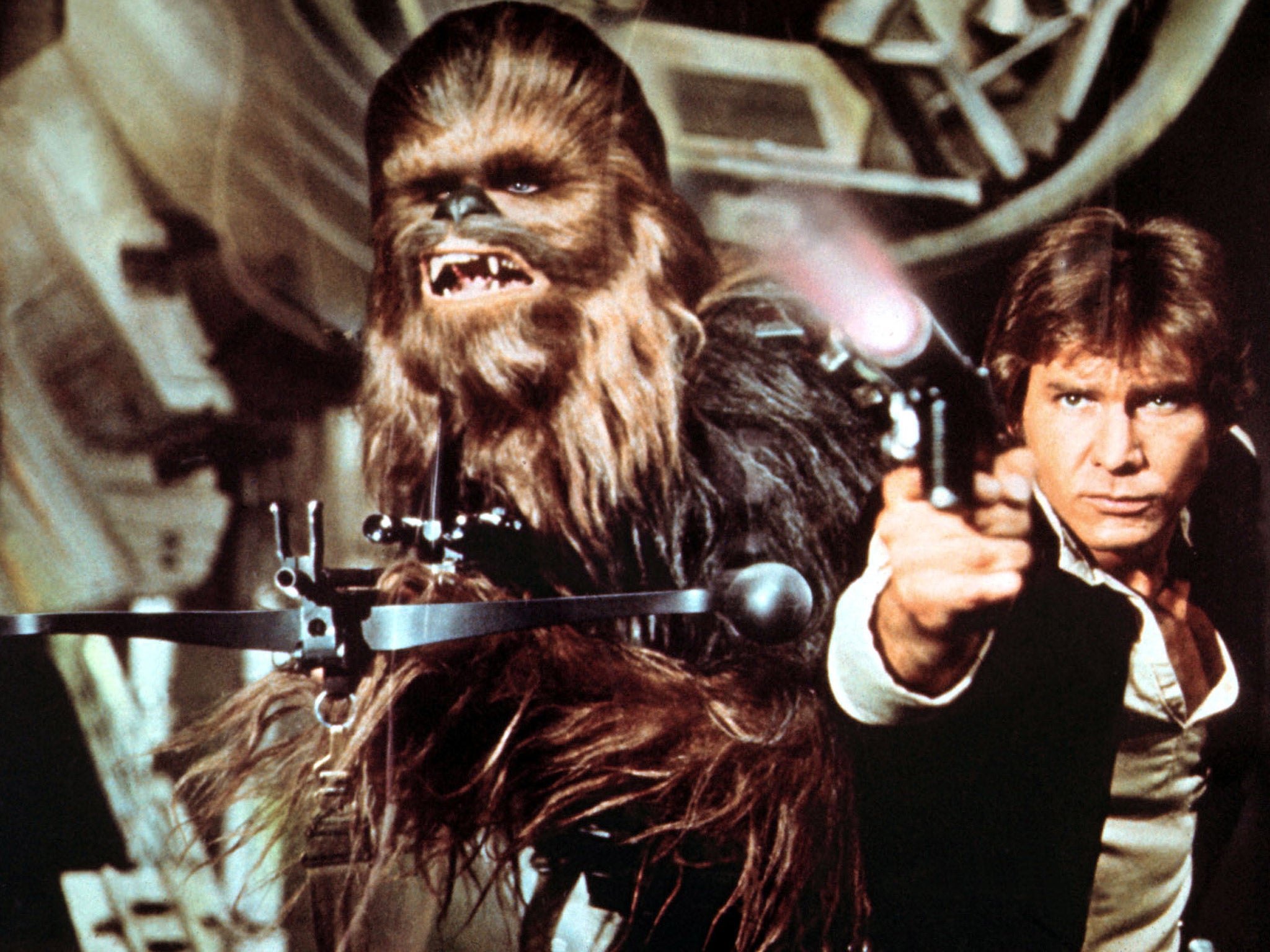Star Wars is the closest thing we have to Homer
Vast dynastic conflicts and reflections on good and evil, has George Lucas been studying the Iliad?


Is this the face that launched a thousand shops? Next week, at the Royal Exchange Theatre in Manchester, the ginger-framed features that have sold couture and cosmetic lines from Chanel through to Rimmel will incarnate a somewhat older brand. Supermodel, environmental campaigner, first-class Cambridge graduate in art history and now actor, Lily Cole will play Helen in The Last Days of Troy, poet Simon Armitage’s new dramatic take on Homer’s Iliad.
“They say that you were born from an egg,” the Trojan king Priam says to Helen in Armitage’s version, “that your father was a swan, hence the whiteness, the pale skin.” That might do as a slogan, even if the priciest moisturising cream can hardly compete with having Zeus for a dad.
A fashion veteran at 27, Cole now seeks a career shift via this adaptation of a poem that, in written form, dates to around 750BC. If it happened at all, the decade-long war that The Iliad commemorates would have taken place five centuries earlier than that. So tales of love and strife that entered the oral tradition of the eastern Mediterranean 3,000 years ago may still sway the future of a 21st-century media celebrity. Homer lives, as do his heroes and his horrors.
Surveying the battlefield mayhem around Troy, Zeus sounds in Armitage’s words like some long-embedded reporter in the dust of Helmand: “Ten years into this most gruelling of military confrontations and we’re still no closer to any kind of resolution.” Now back to the studio on Olympus.
Has George Lucas been studying Homer’s almost godlike powers of reinvention and metamorphosis? His Star Wars cycle of space-opera chronicles will return to the cinema late next year. This seventh episode will recast its original trio of stars from 1977 – Harrison Ford, Carrie Fisher and Mark Hamill – as well as British newcomer, Daisy Ridley. True, Lucas has progressively detached himself from his evergreen brainchild. In 2012, his company Lucasfilm passed into the hands of Disney for $4bn. Yet he remains the Homer, if not the Zeus, of the Star Wars empire, spinning a frequently confusing web of backstories, digressions and revisions around the grand arc of the Skywalker family and the eternal, intimate antagonism of the Jedi and the Sith.
As with the Homeric poems, and every regenerating epic from India to Iceland, Star Wars tugs against its origins. It has grown in ways its begetters could never have envisaged. Directed and co-written by science-fiction maverick JJ Abrams, Episode VII will inhabit a cultural galaxy far, far away from that envisioned by Lucas when he delivered the series embryo to Universal Studios in 1971. Yet the continuities matter. Lucas had reportedly sketched out a dozen segments of the cycle by the 1980s. If so, he commanded truly Homeric powers of patience, endurance and foresight. But thanks to the vagaries of studio finance, box-office receipts, star availability and – not least – the state of the director-producer’s soul, the nine confirmed parts will eventually run in the out-of-kilter sequence of IV, V, VI, I, II, III, VII, VIII, IX.
With its dynastic conflicts, grandiose rhythms of war and peace, reflections on the intertwined nature of good and evil and lacerating inter-generational feuds, the Star Wars saga stands as the nearest thing in mass-media culture to the timeless epics of antiquity. Curiously, however (and proof of our unquenchable appetite for mammoth stories), the Lucas constellation ranks only fifth among money-spinning movie sequences. Harry Potter, Lord of the Rings and James Bond have all earned more. In pure cash terms, the Marvel Comics superheroes from Hulk to Thor have also outgunned Star Wars.
The other franchises also show signs of expansion. Director Sam Mendes revealed on a US chatshow that “Bond 24” – a follow-up to Skyfall due to open late next year – will re-iterate and amplify that film’s themes and relationships. And J K Rowling, who keeps an iron grip on the boy wizard’s legacy via the Pottermore website, has authorised a trilogy of “prequel” films. They will be cultivated from her brief spin-off volume Fantastic Beasts and Where to Find Them.
When will these story wells run dry? On one side stands the keen desire of fans to see their beloved heroes and heroines tread pastures new. On the other, a suspicion rises that that these series have degenerated into ailing cash-cows, their life artificially prolonged for extra profit. Rowling’s Fantastic Beasts project prompted some disenchanted howls of protest. For many critics, the recently released Amazing Spider-Man 2 – the fifth Hollywood blockbuster extruded from the Marvel Comics figure – proved that the narrative thread had dwindled to breaking-point. Meanwhile, Peter Jackson’s tripartite cinematic reboot of Tolkien’s distinctly compact story The Hobbit has underwhelmed both admirers of the book and of Jackson’s, more justifiably gargantuan, Lord of the Rings films. Hubris unchained, Jackson now wants to re-name the third Hobbit film – which until now has had the purely Tolkien-esque working title “There and Back Again” – as “The Battle of the Five Armies”. Enough, already. Or, as Hugo Dyson – Tolkien’s fellow “Inkling” in the pubs of 1940s Oxford – might well have said: “Not another effing CGI elf.”
Even so, the Star Wars numbers supply compelling reasons to crack on with Lucas’s creation. The franchise as a whole has earned around $27bn since 1977. Yet only $4.3bn of that planet-sized cashpile comes from cinema box-office, and $3.8bn from DVD sales. Star Wars toys alone have generated revenues of the order of $12bn. The next time a stray lightsaber catches you a nasty blow during some rowdy kids’ birthday party, you may wish to applaud the diffusion of epic tropes among entire populations on a scale that Balkan bards or Icelandic kalds could never have imagined. Or perhaps not.
So long as they develop a complex, ever-changing morphology and mythology (Star Wars can; Spider-Man cannot), we love such never-ending stories. As have their tellers, hearers and watchers throughout history and across the world. The greatest narrative cycles evolve in constant, restless motion. I spent last week in Trinidad, where in the 19th century, indentured Indian labourers fashioned popular dramas taken from the Hindu epic Ramayana, to be performed over successive afternoons. When the poet Derek Walcott (who lived on the island for decades) received his Nobel Prize in 1992, in his acceptance speech he defended these distant echoes of an ancient source as genuine art rather than faded mimicry. “They were not amateurs but believers,” he said about their actors. “They did not have to psych themselves up to play their roles. Their acting would probably be as buoyant and as natural as those bamboo arrows criss-crossing the afternoon pasture. They believed in what they were playing, in the sacredness of the text, the validity of India.”
Against the 2,700-year evolution of the Homeric poems, or the 2,400-year journey of the Ramayana, the mere 37 years of Star Wars feels like a speck of time. The other gulf that divides traditional reworkings of myth from the modern franchise industry involves the law of intellectual property. However deep their resonance, today’s epics have become protean brands, to be sliced and diced into unending revenue streams across every format and market.
The Star Wars administration even has a “story group”. Its mission is to consolidate, and so control, every character and story element hatched over almost four decades of movies, games, comics and novels. The manager of this “continuity database”, Leland Chee, rejoices in the title of Keeper of the Holocron. Spontaneous reinterpretation, Ramayana-style, might bring copyright lawyers down on the adapter’s head with all the malevolent force of the demon King of Lanka, Ravana. Yet much-loved tales will always tend to slip free of their chains. For Star Wars, Star Trek or Potter himself, fan-fiction sites hosts thousands of unofficial yarns, to the consternation of copyright enforcers.
Given the tedious overstretch of some movie strands, even the greediest gulper of epics may sense a sinking of the heart as the authorised line of prequels and sequels stretches out forever. Where is the Death Star, with its annihilating superlasers, when you really need it? But perhaps the neatest remedy for the weary franchise and the flagging icon lies in the hands of fans themselves. Studio chiefs and their watchful lawyers should study the tireless revisions of the Ramayana across drama, movies, song and dance in every Indian-origin community. Call off the copyright dogs. Give the folks who wish to revere Obi-Wan Kenobi or emulate Harry Potter free rein to rewrite their stories across every kind of interactive online platform. Then (this is Hollywood, remember) harvest the best for a handsome fee.
Self-renewing epics need creative owners – millions of them – as well as brand-loyal customers. Forget that bond of faith rather than cash, and Lucas might as well mutate into his own despotic Emperor Palpatine.
Join our commenting forum
Join thought-provoking conversations, follow other Independent readers and see their replies
Comments